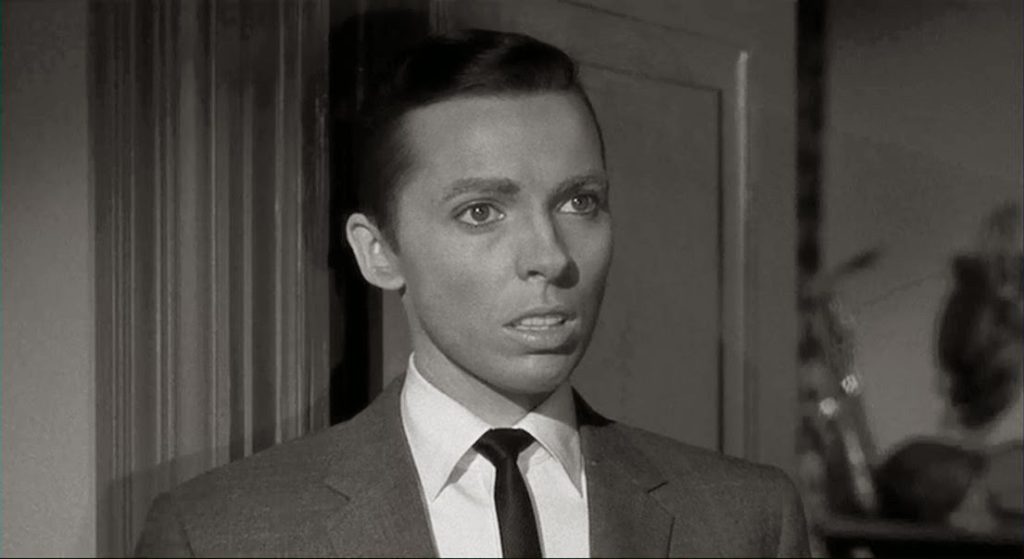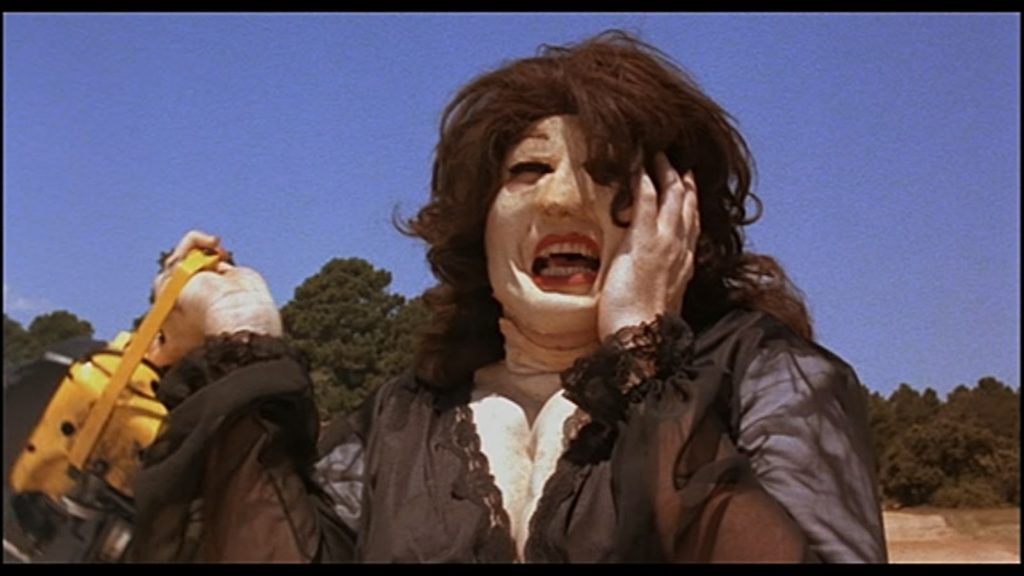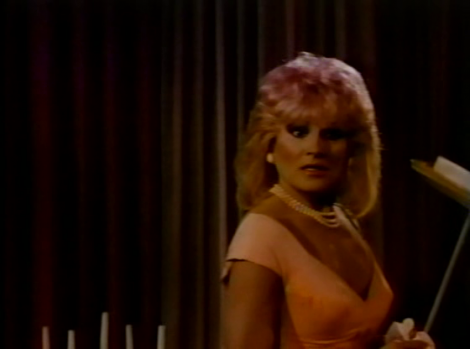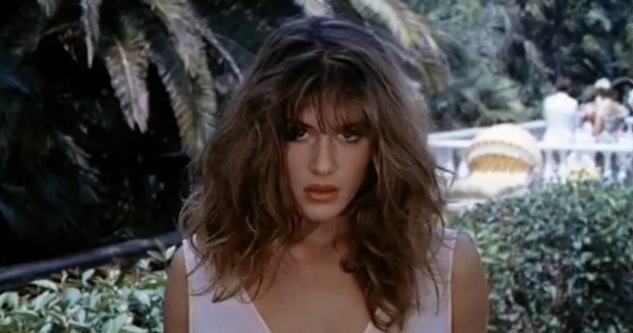Yesterday, we started our countdown of the 50 most fascinating gender-bending characters of exploitation film — if you missed it, check it out here! Today we’ve got another ten folks who won’t be limited to a particular color on the gender spectrum, with aliens, starlets and, of course, murderers! As before, there are spoilers here for some last-minute trans-formative climaxes, so be wary!
40. Nameless Alien
Chris Mulkey, William Boyette, Claudia Christian, Etc.
The Hidden (1987)

The body-shifting alien without a distinct human gender isn’t a completely unique concept – the quest for the bounty hunting alien of CRITTERS 2 to find a comfortable form leads to a memorable impersonation of a Playboy centerfold – but THE HIDDEN’s pair of parasites have distinct personalities that make for compelling viewing. Sure, you can root for the space cop that inhabits the body of Kyle McLachlan’s FBI agent for much of the film, but the sheer drive-in value is all in his prey, who jumps bodies and genders with wild abandon.
While it doesn’t speak a whole lot, blurting out words only when its desires need to be met, the rampage of mayhem it creates paints it as the alien embodiment of a psychotic polysexual frat boy who just wants to immerse itself in as much sex, drugs, violence and loud music in its immediate vicinity as it possibly can. In the body of art gallery owner (Frank Renzulli), “he” goes to strip club, where he takes Claudia Christian’s gyrating body instead, using it for a quick tryst with a man who loses both his car and life in the process. Gender? THE HIDDEN says fuck it, and let chaos reign.
39. Arachne
Christopher Rage
Drive (1974)

There are plenty of compellingly deranged transgendered characters on this list, but Arachne may be the only one bent on world domination. DRIVE is a wild spectacle of adults-only entertainment from director Jack Deveau, whose Hand in Hand Films is generally considered to be one of the finest producers of all-male skin flicks. The plot concerns Arachne, played by co-writer Rage (under the psuedonym “Mary Jim Sstunning”) attempting to steal a secret formula that would destroy the sex drives of all men, in an effort to “free all men, liberate them as I am liberated, unshackle them from the bonds of their carnal drive and elevate them to a higher way of life.”
Sure, there’s plenty of man-on-man action on display in DRIVE, but Deveau shoots and edits the sex scenes with the flair of a deranged artist, interspersing shots of a circus during one scene, coupling a sequence of double-fisting with sounds of an elephant’s roar, and introducing Arachne during another by cutting away to her entering a club in a gorilla costume. She also sings “I’m Forever Blowing Bubbles.” She’s such a weird, inexplicable presence that you kind of wish for her plot to work, and it’s inevitably disappointing when she finds her work foiled by the sight of a large, erect cock.
38. Emily/Warren
Joan Marshall (“Jean Arless”)
Homicidal (1961)

When William Castle decides he’s going to rip a movie off, he knows no limits. Not only does HOMICIDAL share a similar title and gender-bending nature to the previous year’s PSYCHO, but It even throws in a memorable stair-related death and a post-climax coda full of “psychological” mumbo jumbo as well! The one thing he doesn’t really pull off is the “twist,” as it’s clear as soon as soon as he appears that there’s something very wrong with Warren, the brother half of a pair of mixed-gendered siblings set to inherit a fortune after the death of their father, as he sounds odd, speaking through clenched teeth and looking just… off.
The truth is that he’s played by Joan Mashall, billed as Jean Arless, the same actress who plays Emily, the psychotic nurse who “Warren” has hired in order to take care of an elderly family servant. A solidly intriguing first ten minutes aside, HOMICIDAL is a lot of filler until it gets to the climax where the discovery that Warren and Emily are the same person is made – Warren is, in fact, a girl raised as a boy due to a misogynistic father who invented a female identity in order to bump off those who might know – and we get a lot of time with Warren’s half-sister Miriam, who is generally useless. Marshall’s performance as Warren isn’t the least bit convincing, but she does give good crazy eye as Emily, and the brief moments of psychotic lunacy make HOMICIDAL worth at least one watch.
37. Leatherface
Robert Jacks
The Return of the Texas Chainsaw Massacre (1994)

There’s no question that Kim Henkel’s THE RETURN OF THE TEXAS CHAINSAW MASSACRE was a bit of a mess in terms of production and distribution. An oddly satirical horror film that seems to be a riff on the first TEXAS CHAIN SAW MASSACRE, RETURN follows a number of unconvincing and/or unsympathetic high school students (including Renee Zellweger) who end up at the mercy of a whacked-out family (including Leatherface) headed by Vilmer, a deranged tow truck driver with a cybernetic leg played to the hilt by Matthew McConaughey. The Illuminati is also involved.
With as over-the-top as the plotting and performances are, Leatherface’s tendency to fill the family’s matriarchal role by donning a wig and women’s clothing isn’t all that shocking, even if the results are nowhere near the sultry Leatherface depicted on the U.S. VHS release under the TEXAS CHAINSAW MASSACRE: THE NEXT GENERATION title. What is surprising is Leatherface comes off like a battered wife, always at Vilmer’s mercy, and the late Jacks’ portrayal of the iconic slaughterer only revs into high gear under orders or after his/her family has been wronged. There’s an interesting idea somewhere in Henkel’s script behind the concept for Leatherface’s character, but like much of RETURN, it’s a bit too much of a clusterfuck to figure out.
36. Groovin’ Gary/Groovin’ Larry
Richard LaVon Griffiths/Sean Penn/Crispin Glover
The Beaver Trilogy (1979/1981/1985)

Railroad worker “Groovin’ Gary” just wanted to pay homage to Olivia Newton-John. When director Trent Harris (RUBIN AND ED) discovered him in a Salt Lake City parking lot, Gary excitedly introduced himself to the camera crew as an impressionist, his tic-like laughter punctuating every sentence. Harris followed Gary’s performance as Newton-John at a talent show in Beaver, Utah, and that fascinating footage of a female impersonation in a small town makes for the first fascinating third of THE BEAVER TRILOGY.
But that’s not all there is. Harris followed this short with BEAVER KID #2, a cheaply-shot fictionalized version of Gary’s talent show dreams starring Sean Penn in the lead. The short depicts Harris’s own reactions to the 21-year-old kid which, much as that of the audience of the first short in 1979 must have been, begin as mocking. Slowly, however, the director becomes captivated by this nice guy’s honest attempts to pay tribute to his idol despite attacks on his heterosexuality, and it’s hard to imagine any audience member not doing the same. THE ORKLY KID, a more polished version of the story starring Crispin Glover, E.G. Daily and Courtney Gains, completes the journey from real-life documentary to flashy biopic. Even though THE BEAVER TRILOGY is the same story repeated three times, it’s never less than compelling thanks to the enigmatic, but no doubt not unique, man who inspired it all.
35. George/Christine Jorgensen
John Hansen
The Christine Jorgensen Story (1970)

The story of Christine Jorgensen, the first widely-recognized American to have sex reassignment surgery, was supposed to have been the impetus for Ed Wood’s GLEN OR GLENDA, but the resulting film had about as much to do with Jorgensen as HOWLING III has to do with the Gary Brandner book of the same name. It wasn’t until 1970 when actor John Hanson took the role on in this soapy biopic from Irving Rapper, the director of such notable works as NOW, VOYAGER and 1950’s THE GLASS MENAGERIE.
The results are very much a product of the era, a time when Hollywood was serving up modern-day issues in a package of melodrama, and THE CHRISTINE JORGENSEN STORY is pitched just below any given Jacqueline Susann adaptation. But it is the first time a transgendered character was the focus of a major studio film, and Hanson makes for a compelling, if relatively bland, lead, working her way through the operation and its aftermath, and her (fictional) relationship with a reporter who covers her story.
34. Dinah East
Jeremy Stockwell
Dinah East (1970)

Released the same year that Christine Jorgensen’s story was depicted on screen, musician Gene Nash’s wild “biopic,” allegedly based loosely on the life of Mae West (!), ranks as a much more exploitative tale of gender displacement. The title character, a reclusive one-time sex symbol and movie starlet, collapses and dies in her limousine. When the lecherous coroner tries to cop a feel on her lifeless corpse, he discovers that she’s been hiding her male candy for years, and the resulting scandal shocks everyone who knew her.
The rest of the film is essentially the CITIZEN KANE of transploitation, as we follow various friends and family (including a son!) of East, and each of them flashes back to their times together. Virtually all of these times involve nudity of all types, and there’s even some lesbianism thrown in for good measure. Stockwell is an enigmatic lead, delivering nearly ridiculous lines with the utmost of conviction, and despite the fact that this is clearly a work of equal-opportunity exploitation, there’s plenty of both entertainment and sincerity to be had. DINAH EAST is unjustly obscure, mostly due to its unavailability and the fact that it never reaches the histrionics of MYRA BRECKINRIDGE or BEYOND THE VALLEY OF THE DOLLS, but it’s still a hell of a lot of skin-filled fun.
33. Richard Garcia / Ramon Garcia / Esperanza / Virginia Garcia / Female Performer / Olivia Mann
Jim Bailey
Vultures (1984)

Alec Guiness gets plenty of respect for playing eight characters in 1949’s KIND HEARTS AND CORONETS and Eddie Murphy regularly makes playing several roles a bit in his films, but the king of the multiple roles in exploitation films clearly belongs to Jim Bailey, who takes on a half-dozen roles in Paul Leder’s flick about a dying patriarch whose family begins offing each other for the inheritance. Three of the roles are male, but three are female, including a Barbra Streisand impersonator — and they all come together in the climax that most viewers will probably have figured out by the end of the opening credits.
Bailey’s performances as a male are a little stiff, but as a woman, he’s fantastic, managing to be the most compelling character in a film that has Yvonne DeCarlo spouting dialogue like “I can’t think and fuck at the same time.” Bailey also appeared as a cross-dressing character in THE SURROGATE and Jamaa Fanaka’s PENITENTIARY III, his role in the later severely truncated before the film’s release, but VULTURES is his magnum opus, featuring a Norma Desmond-esque climax that leaves no scenery unchewed.
32. Casey Kaufman
Will Keenan
Terror Firmer (2008)

Don’t expect any kind of “positive” portrayal of a trans person in TERROR FIRMER, Lloyd Kaufman’s unbridled tribute to low-budget cinema, his own 8 1/2. Casey Kaufman is undeniably psychotic, wearing women’s clothing as he gleefully slaughters members of the film crew he’s working on by stabbing them with broken bongs or ripping off their cocks in graphic, splattery detail.
But like the best of Troma films, TERROR FIRMER is an equal-opportunity offender, just trying to find the most outrageous way to depict any given situation. Casey’s trans nature isn’t really the outrageous part — it’s that the hermaphroditic-born boom mike operator had his genitalia mutilated by his father (Ron Jeremy) who also sexually abused him repeatedly, and now Casey has him locked in his apartment and keeps various body parts of his in pickle jars. Keenan’s portrayal and Kaufman’s take don’t come from a transphobic place, instead coming off like an outrageous parody of the trans-killer cliche. (The film crew within the movie even includes an actual sympathetic gay character and an assistant who seems to change genders as the film progresses, played by drag king Mo Fischer.) Troma is a land where a “life-affirming rape scene” turns into a plot point, so that audiences can bask in a make-up wearing homicidal maniac yelling “the whole damn crew could smell the damn stench of your perfectly-functioning little pussy” seems par for the course. In proper Troma tradition, Casey’s “sin” seems to have less to do with any sexual issues than with the fact that he ran away from what made him unique and embraced “family values” and the films of Penny Marshall.
31. Lana and Pepper
Romy Haag and Eva Robin’s
Mascara (1987)

An oddity even by the standards of Cannon Films’ imports, Patrick Conrad’s MASCARA is a psychothriller set in the world of underground Dutch transvestite clubs, starring Michael Sarrazin as Bert, a police detective with odd relationships with both the clubs and his sister (Charlotte Rampling). The gender-bending aspects weren’t mentioned in the promos for the film, and you could certainly watch the first half hour without realizing that there were transgender characters if you weren’t paying much attention. Eva Robin’s, an intersex actress who played Dedalos in the Lou Ferrigno HERCULES films, gets the big reveal moment as Bert’s friend/lover(?) Pepper when while changing, her male appendage appears, accompanied by a musical key so ominous you’d think she was seducing her father. She soon finds herself on the wrong end of a throat throttle and ends up a classical queer victim, replaced by Romy Haag’s Lana, another singer at the club, who pressures Bert to find her friend’s killer and ends up replacing her in more ways than one.
MASCARA naively blends transsexualism with multiple kinks, resulting in a club that features female impersonators performing while leather-masked fetishists spit food into each other’s mouths like birds, making the underground feel more like a mad compilation of Weimar-era Berlin rather than a place where professionals of the ‘80s would go for a good time. Fortunately, the performances are more than up to the task of enhancing the muddled material. Haag lip-syncs to her own music (an odd effect) and creates a memorable sympathetic character, and another performer executes a French version of Kansas Joe McCoy’s “Why Don’t You Do Right?” a year before Jessica Rabbit brought the song back into the popular consciousness. It’s a shame the film has yet to land on DVD, as the VHS transfer muddies the gorgeous costumes and performances, leaving just the confusing plot to latch on to, the results of which have most likely relegated MASCARA to obscurity.
Check out Part 3 here!
@Paul Freitag-Fey
- [THE BIG QUESTION] WHAT’S YOUR FAVORITE FEMALE ENSEMBLE IN MOVIES? - July 22, 2016
- [IN THEATERS NOW] THE BOY (2016) - January 24, 2016
- Cult Movie Mania Releases Lucio Fulci Limited Edition VHS Sets - January 5, 2016
Tags: Jim Bailey, the hidden, top 10, transgender, Troma





No Comments